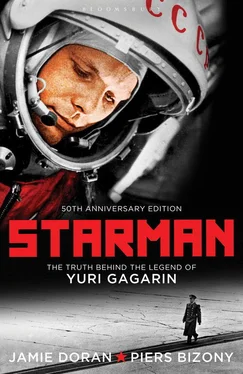Soyuz was a key element in future lunar plans, but it would not be ready for another two years at least. In the meantime, Konstantin Feoktistov, one of Korolev’s most trusted engineers and a close colleague of Oleg Ivanovsky, was developing Voskhod as fast as was humanly possible, so that Korolev could fulfil his private ‘deal’ with Khrushchev. Feoktistov was also training to fly in Voskhod as the first specialist engineer-cosmonaut, along with the nine other engineers from OKB-1 who had passed the (by now much simpler) medical qualifications. Either this was Feoktistov’s way of showing faith in his own work or it was Korolev’s gesture of thanks for developing Voskhod so quickly. Feoktistov was the only person within OKB-1 who never gave ground to the Chief Designer on technical matters. In their stubborn fearlessness, the two men were remarkably alike – the world having already done its worst to them. While Korolev came come close to death in a Siberian prison camp, Feoktistov fought for the Red Army and was captured by the Nazis. After a brutal interrogation, they lined him up against a ditch and opened fire. He fell onto a pile of dead bodies and hid under them until nightfall, until he could limp away. The Voskhod capsule cannot have held many terrors for him. [3] Hooper, The Soviet Cosmonaut Team , Vol. II, pp. 75–6. See also: Harford, Korolev , pp. 165–6.
As Feoktistov and other highly skilled and experienced men like him began to rise in the cosmonaut hierarchy, so the chances were lessened for Gagarin to catch up with his studies and earn another flight into space.
In between his foreign trips, Gagarin had attended cosmonaut lectures as often as possible, but on many occasions he took his seat in the classroom only to be called away at short notice for some diplomatic function or other. When Khrushchev’s administration ran into trouble from 1963, Gagarin managed to extend his academic work because he was not required to be quite so much in the limelight. In March 1964 he came to the Zhukovsky Academy in Moscow, a renowned school covering all aspects of aviation and aerodynamics, housed in the elegant Petrovsky Palace on Leningradsky Prospekt. Catherine the Great built Petrovsky Palace as a rest-stop for royal travellers, and Napoleon sheltered within its crenellated walls during the fire of Moscow in 1812. Now it was a necessary stop for cosmonauts on their way up into space. A special course had been established for the new science of space flight: the ‘Pilot-Engineer-Cosmonaut Diploma’. Candidates would have to study all aspects of space and contribute a thesis in a chosen field of specialization, which they would then defend before their tutors in written and oral sessions at the end of the course. The cosmonauts were becoming more like their American counterparts, who also undertook diploma work to qualify themselves for space flight. (In a notable thesis, NASA recruit Buzz Aldrin outlined the mathematics for orbital rendezvous, thus earning himself a secure ranking in the astronaut corps.)
With every intention of making his mark at Zhukovsky, Gagarin selected for his thesis nothing less than the holy grail of manned space flight: a practical design for a reusable winged space plane. Alexei Leonov, who studied with him for several months, recalls, ‘He was very strict with himself. I was always amazed how conscientious he was about his studies, how thoroughly and painstakingly he prepared his work, and how hard he tried to keep up with the others. Somebody who was full of airs and graces wouldn’t have put himself through all that.’
Obviously a spaceship with wings could come home in an orderly fashion, landing at an airbase instead of falling down into a ploughed field or splashing into the sea. The wings would slow and control the final descent, so that the ship could touch down softly on wheels. Unlike the clumsy space capsules, a winged craft could be refurbished for another flight. The difficulty was to balance the aerodynamic usefulness of wings with the need for bulky re-entry heat-shielding. NASA had already started work on so-called ‘lifting bodies’, experimental craft that were neither capsules nor aircraft but something in between. They were dropped at great altitude from beneath the wings of B-52 bombers, and most of them landed successfully. However, it was impossible to send them into space because the addition of rocket engines and fuel tanks would have made them too heavy; and there was the intractable problem of the heat-shielding. At that time no sufficiently strong and lightweight material seemed capable of protecting the lifting body’s stubby wings against melting away during re-entry. The ‘ablative’ heat-shielding of conventional capsules was thick and heavy, and it burned away irretrievably, leaving terrible scars on the capsule’s flanks. The bulky resins and fibres used for the shields were completely unsuitable for wings.
In all, the spaceplane presented the most complex technical challenge. Even the current NASA space shuttle is a flawed design, consisting as it does of heavy components and throwaway tanks, with clumsy ceramic tiles to protect it against the heat. The search is still on for a genuinely efficient design. For Gagarin to research into these issues in the mid-1960s was proof of his great seriousness in attempting to re-qualify for space flight. Today few people remember his engineering skills; only his simple farmboy’s smile. His painstaking and disciplined diploma work at the Zhukovsky Academy has been entirely forgotten except by his closest colleagues – in particular Sergei Belotserkovsky, the Deputy Director at Zhukovsky and the man who, more than any other, was responsible for the cosmonauts’ academic skills in space flight and orbital dynamics (while Kamanin and the specialists at Star City taught them how to operate the hardware).
One of Gagarin’s most significant achievements was to understand that, for safety reasons, his spaceplane had to be capable of an unpowered landing. Some of his tutors insisted that this was not technically possible. Gagarin argued that the spaceplane was useless if it could not make a ‘deadstick’ descent. After all, how could the crew get back if their engines failed? Just as for the Vostok capsules, a small braking motor should be enough to nudge the spaceplane out of orbit, he insisted; after that, it should be capable of reaching the ground without engines. His first solution was to bring the plane down by parachute, but of course that idea missed the point. Eventually he decided that it should glide to its landing. NASA’s modern shuttles do precisely that, with no use of engines during their final approaches.
In some crucial aspects, Gagarin’s thinking on the spaceplane concept outstripped that of his tutors; but on matters of strict aerodynamic science they pushed him hard. How would his spaceplane react to tail winds, head winds and cross winds? What about sudden, brief gusts? Had he calculated the drastic change of airflow as the ship neared the ground? Time and again Gagarin ran complicated mathematical simulations on primitive analogue computers (alongside his friend and collaborator Andrian Nikolayev), attempting to mate the airflow numbers to his ideal design. He revelled in the cut-and-thrust arguments with his tutors and collaborators, constantly striving to improve his ideas. [4] Details of Gagarin’s diploma work are derived from extensive interviews with Sergei Belotserkovsky, his tutor at the Zhukovsky Academy.
Gagarin’s spaceplane work was considered top-secret – in fact, all of the diploma work conducted at Zhukovsky was highly classified. Just as for Korolev, Belotserkovsky’s identity was a secret and he was never acknowledged in public. He was not even allowed to take snapshots of his favourite pupils, in case Western spies should identify them. Even so, he used a hidden camera to obtain his keepsakes. ‘We hid all the films in a safe, and developed them a long time later. I don’t think we did anything wrong. Thanks to our unofficial action, we have an important and historical collection of photographs today.’
Читать дальше












